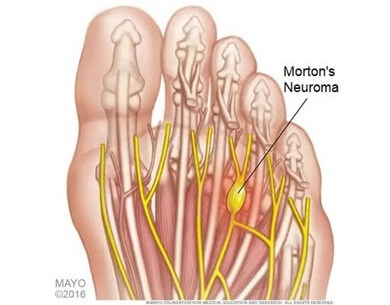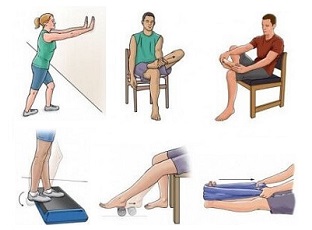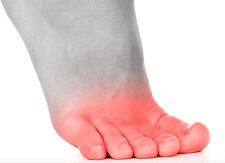- Home
- Common Foot Problems
- Metatarsalgia
Metatarsalgia
Written By: Chloe Wilson BSc(Hons) Physiotherapy
Reviewed By: FPE Medical Review Board
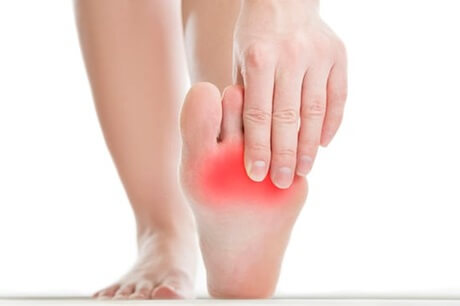
Metatarsalgia is a common cause of pain and inflammation in the ball of the foot.
It is typically caused by overuse or repetitive pressure through the front of the foot from activities such as walking, running, jumping or prolonged standing.
Tight-fitting footwear, certain medical conditions, altered foot biomechanics, muscle tightness and weakness can all increase the risk of developing foot metatarsalgia.
In most cases, metatarsal bone pain is nothing serious but it can significantly affect your daily activities. Treatment usually involves a combination or rest, ice, medication, exercises, physical therapy, insoles and metatarsal pads.
Here we look at what is metatarsalgia, the common causes and symptoms, how it is diagnosed and the best treatment options. You will also find answers to frequently asked question about metatarsal pain.
What is Metatarsalgia?
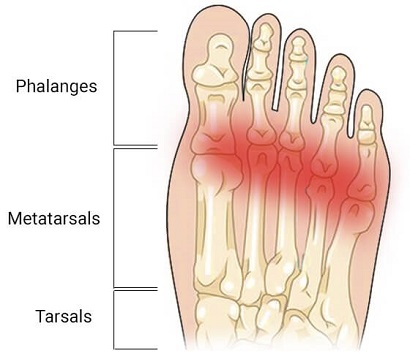
Metatarsalgia refers to pain and inflammation in the ball of the foot, the area between your toes and your foot arch.
It typically affects the metatarsal heads - the area on the end of the long foot bones that join to the toe bones.
These bones bear a significant amount of body weight during walking and running and can easily become irritated or overloaded. This can lead to discomfort, known as metatarsalgia, a common cause of ball of foot pain that affects daily activities and exercise.
Metatarsalgia is usually due to an underlying problem, such as overuse, improper footwear, or abnormal foot mechanics. The pain is often described as a sharp, aching, or burning sensation, especially during weight-bearing activities like walking, running, or standing for extended periods.
Metatarsal bone pain can affect one or multiple metatarsal heads, and it can impact anyone, though athletes and those with high-impact lifestyles are particularly susceptible.
What Causes Metatarsalgia?
Several factors can contribute to the development of metatarsal pain, including:
1. Foot Shape and Biomechanics
People with certain foot shapes are more prone to metatarsalgia. Those with high arches place extra pressure on the metatarsal heads, while people with flat feet may experience misalignment that leads to metatarsal overload.
Additionally, having an abnormally long second toe can shift weight to the front of the foot, increasing the risk of metatarsal pain.
2. Overuse or High-Impact Activities
Excessive exercise, particularly running, jumping, and sports that involve repetitive foot impact (like basketball or soccer) can strain the metatarsal bones. The constant pounding on hard surfaces, especially in poorly cushioned footwear, can irritate the metatarsal heads and surrounding tissues, leading to metatarsalgia.
3. Ill-Fitting Footwear
Wearing shoes that are too tight, have high heels, narrow toe boxes, rigid soles, or provide inadequate arch support can exacerbate pressure through the metatarsal heads. For example, high heels force the foot forwards, concentrating body weight on the ball of the foot, while narrow shoes can compress the metatarsals.
4. Being Overweight
Excess body weight can increase the pressure on the front of the foot, especially during weight-bearing activities. This added strain on the metatarsals can cause inflammation and pain.
5. Foot Deformities
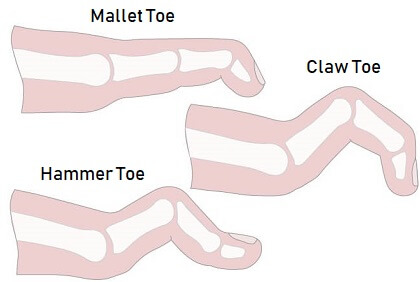
Conditions like hammertoes, bunions, and claw toes can alter foot mechanics, increasing pressure on certain metatarsal heads.
Each of these foot deformities change the position of the toe bones in various ways which alters how the forces go through the metatarsal bones and how they move.
This abnormal distribution of weight makes certain areas more susceptible to pain and inflammation.
6. Stress Fractures or Injuries
A stress fracture in the metatarsal bones, often caused by repetitive activity or sudden increase in physical activity, can lead to metatarsalgia-like pain. Trauma to the foot, such as landing heavily on it, can also trigger metatarsal bone pain.
7. Stiffness Or Tightness
Any stiffness in the foot or tightness in the muscles, especially the calf muscles/Achilles tendon, can affect the way pressure is distributed across the foot. This can lead to excess pressure through the metatarsal heads and lead to metatarsalgia.
8. Foot Conditions
Underlying foot conditions, such as bursitis, arthritis, diabetes and gout can also lead to metatarsalgia. The most common is Morton’s neuroma, where there is thickening around one of the nerves as it passes between the metatarsal heads.
Symptoms of Metatarsalgia
The primary symptom of metatarsalgia is pain in the ball of the foot, but the intensity and location of the discomfort can vary depending on the underlying cause. Common symptoms include:
- Ball Of Foot Pain: Metatarsal pain is typically a sharp, aching, or burning pain in the ball of the foot. It is often worsened by activity e.g. standing, walking, or running, or flexing the toes, particularly if you are barefoot or on a hard surface. The pain may be focused underneath just one or two metatarsal heads or across all of them and usually improves with rest.
- Discomfort: It may feel like you have a pebble in your shoe or that you are walking on a small stone.
- Altered Sensation: There may be numbness or tingling in the toes, if there is irritation of the nearby nerves.
- Swelling: there may be some inflammation or bruising in some cases, particularly if a stress fracture or injury is involved.
Metatarsalgia may affect one or both feet at the same time.
Diagnosis of Metatarsalgia
Diagnosing metatarsalgia involves a thorough evaluation by a healthcare provider:
- Medical History and Symptoms: Your doctor will ask about your symptoms, lifestyle, footwear choices, and any recent changes in physical activity. They may also inquire about any underlying foot conditions or past injuries.
- Physical Examination: During the examination, your doctor will check for areas of tenderness, swelling, or deformity in the foot. They may manipulate your foot to assess flexibility, range of motion, and the alignment of the metatarsal bones.
- Gait Analysis: In some cases, a gait analysis is performed to assess how you walk and whether abnormal biomechanics are placing excess pressure on certain parts of the foot.
- Imaging Tests: To rule out other conditions like stress fractures or arthritis, your doctor may order X-rays, an MRI, or ultrasound imaging. These tests can reveal any bone abnormalities, fractures, or soft tissue injuries that may be contributing to the pain.
- Blood Tests: Your doctor may send you for blood tests to check for systemic conditions such as diabetes or gout.
Metatarsalgia is just one possible cause of ball of foot pain, others include:
Find out about the different causes and how to treat them in the Ball Of Foot Pain section.
Treatment of Metatarsalgia
Metatarsalgia treatment will depend on the severity and cause of your pain but typically focuses on relieving pain, reducing inflammation, improving function and addressing any underlying causes. Common treatment options for metatarsal foot pain include:
1. Rest and Activity Modification
Giving the foot time to heal by resting is essential with metatarsalgia. Avoid activities that put pressure on the ball of the foot, such as running or jumping. Switch to low-impact activities like swimming or cycling until the pain subsides. If you stand a lot during the day, make sure you take regularly rest breaks.
2. Ice and Elevation
Applying ice to the painful area for 15-20 minutes several times a day can help reduce swelling and relieve pain. Elevating the foot, particularly after activity, can also help reduce any inflammation.
3. Proper Footwear
Wearing well-fitted shoes with a wide toe box, cushioned insoles, and proper arch support can alleviate pressure on the metatarsal bone heads. Avoid high heels and tight shoes that compress the front of the foot. Oofos and Sketchers are popular brands of shoe that provide cushioning and support for metatarsal pain.
4. Orthotics
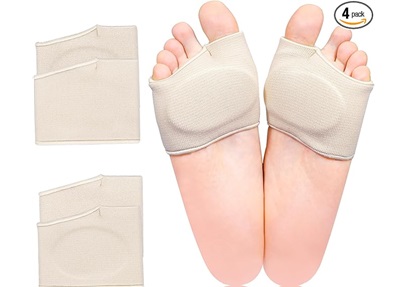
Custom or over-the-counter orthotics, such as arch supports, can help distribute weight more evenly across the foot, reducing pressure on the metatarsals.
Metatarsal pads placed inside the shoe can also provide extra cushioning to the ball of the foot which helps reduce pain and irritation.
Both of these options are a cheap but really effective treatment tool for metatarsal pain.
5. Physical Therapy
A physical therapist can recommend metatarsalgia exercises to strengthen the muscles in your foot and improve flexibility.
A combination of foot strengthening exercises and heel stretches tend to be the most effective for reducing the strain on the metatarsals.
6. Medications
Over-the-counter pain relievers, such as paracetamol/acetaminophen, or non-steroidal anti-inflammatories (NSAID’s) e.g. ibuprofen/Advil, can help manage pain and reduce inflammation.
In some cases, your doctor may recommend corticosteroid injections to reduce inflammation in severe cases but this is fairly rare with metatarsalgia. Always check with your doctor/pharmacist before taking any new medications.
7. Healthy Lifestyle
Ensure you have a healthy, balanced diet, and if you are overweight, try to lose some weight.
8. Surgery
Surgery is rarely necessary for metatarsal pain but may be considered in cases where conservative treatments have failed. Surgical options may involve realigning the metatarsal bones or removing a portion of the bursa or nerve causing the pain.
When Should You See a Doctor?
While mild cases of metatarsalgia can often be managed at home with rest, ice, and proper footwear, there are times when you should seek medical attention:
- Persistent Pain: If the pain in the ball of your foot lasts for more than a few days, despite rest and self-care, it’s time to consult a doctor.
- Severe Pain or Sudden Onset: If your foot pain is intense or comes on suddenly, especially after a specific injury, you should see a healthcare provider to rule out conditions like stress fractures or nerve damage.
- Swelling or Bruising: Significant swelling, redness, or bruising around the foot could indicate a more serious issue, such as a fracture or infection, requiring medical evaluation.
- Difficulty Walking: If metatarsalgia makes walking or weight-bearing activities difficult or impossible, it's crucial to seek professional advice to avoid further complications.
- Numbness or Tingling: Persistent numbness or tingling in the toes could indicate nerve involvement, which should be evaluated by a healthcare provider.
- Ineffective Home Treatments: If home treatments like ice, rest, or pain relievers don’t provide relief, or symptoms return frequently, a doctor’s assessment is necessary to identify the underlying cause and develop a more targeted treatment plan.
Frequently Asked Questions
1. How Did I Get Metatarsalgia?
1. How Did I Get Metatarsalgia?
Metatarsalgia can develop due to overuse, high-impact activities (like running or jumping), wearing ill-fitting shoes, abnormal foot biomechanics, or conditions such as high arches, flat feet, or bunions.
2. What Happens If Metatarsalgia Is Left Untreated?
2. What Happens If Metatarsalgia Is Left Untreated?
If left untreated, metatarsal bone pain can worsen over time, leading to chronic pain, changes in your gait, and further complications like stress fractures or other foot issues. The earlier you start treatment, the quicker the condition will resolve.
3. What Are The Best Exercises For Metatarsalgia?
3. What Are The Best Exercises For Metatarsalgia?
A combination of strengthening and stretching metatarsalgia exercises usually work best. Foot & ankle strengthening exercises help support the foot better and distribute forces more evenly across the foot. Heel stretches targeting the calf muscles and the bottom of the foot can make a big difference.
4. What Are The Best Metatarsal Pads & Insoles?
4. What Are The Best Metatarsal Pads & Insoles?
Gel or cushion metatarsal pads that cushion the ball of the foot and distribute pressure evenly can help alleviate symptoms.
Orthotic insoles with good arch support and cushioning are also beneficial. Full length ones tend to work best for metatarsal bone pain. There are lots of different brands on the market, but popular ones include Cushwork and TrustFeet.
5. What Are The Best Metatarsalgia Shoes?
5. What Are The Best Metatarsalgia Shoes?
6. Is Metatarsalgia A Type Of Plantar Fasciitis?
6. Is Metatarsalgia A Type Of Plantar Fasciitis?
No, metatarsalgia and plantar fasciitis are different conditions. Metatarsalgia affects the ball of the foot, and indicates a problem in the metatarsal bones. Plantar fasciitis causes pain in the heel and along the bottom of the foot, caused by inflammation and tightness in the thick band that runs underneath your foot.
7. How Can I Prevent Metatarsalgia?
7. How Can I Prevent Metatarsalgia?
You can reduce the risk of developing metatarsal pain by wearing well-fitting, supportive shoes, using orthotics if necessary, maintaining a healthy weight, avoiding high-impact activities on hard surfaces, and gradually increasing activity levels to avoid overuse.
Summary
Metatarsalgia is a painful condition that can interfere with daily activities, especially those involving prolonged standing or walking. It’s often caused by overuse, improper footwear, or biomechanical issues, but with proper diagnosis and treatment, most cases of metatarsalgia can be managed effectively at home.
If you experience persistent pain in the ball of your foot, it’s essential to seek medical advice for an accurate diagnosis and to develop a treatment plan that can help you return to normal activities, pain-free.
You may also be interested in the following articles:
- Ball Of Foot Pain
- Foot Arch Pain
- Lump On Bottom Of Foot
- Foot Swelling: Causes & Treatment
- Foot Pain When Walking
Related Articles
Page Last Updated: 5th February, 2025
Next Review Due: 5th February, 2027
